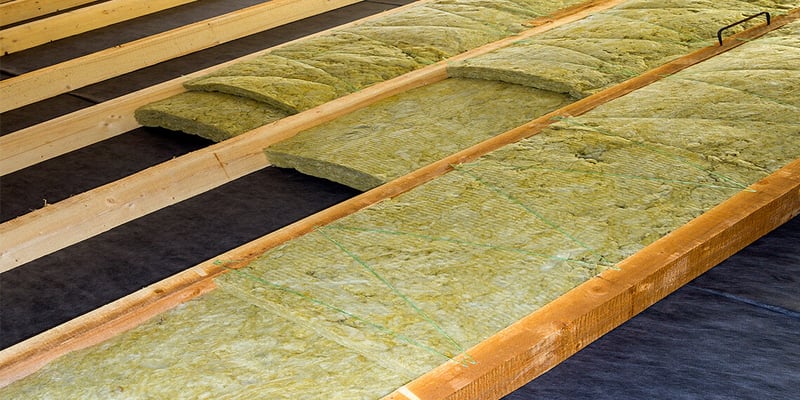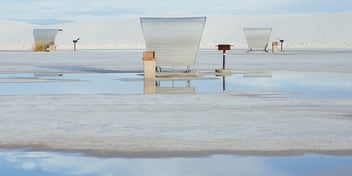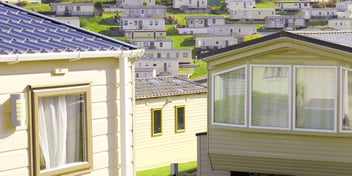- Home »
- Learningcenter »
- Inverted roof membrane assembly
FAQ: What is an Inverted Roof Membrane Assembly (IRMA)?

Did you know that the way your roof is built can really affect how long it lasts and how well it works? If you've ever been curious about how different roofing systems are put together, you're not the only one - you're probably looking for more info on Inverted Roof Membrane Assemblies (IRMAs). People have questions about them!
With an Inverted Roof Membrane Assembly, you place the insulation above the waterproofing layer. This system stands out because it has something special. You need to get a good understanding of this if you're in roofing or construction. You'll learn about IRMA's core parts, its benefits, and why you might want to pick it for your next project.
So - let's get started!
What Is An IRMA Roof?
An Inverted Roof Membrane Assembly is a kind of roofing system that flips the usual setup on its head. The insulation sits below the waterproofing layer in a traditional roof. But with IRMA, you lay the waterproofing membrane right on the base first - then you add insulation, followed by a surfacing material like pavers, ballast, or even vegetation with soil. Sounds a bit odd at first, right? But there's a reason for this!
Let's break it down a bit more. The waterproofing membrane is the main part here - it gets applied directly on the roof's base. Normally, insulation would protect the membrane, but in an IRMA setup, the membrane gets the spotlight. This positioning helps it stay away from UV damage, temperature changes, and other dangers like heavy foot traffic or hail. A big plus, right? It gives your roof some extra durability, which is pretty helpful.
Next, the insulation layer goes on top, which is the opposite of the usual way. This unusual order has its benefits - with insulation as the first defense, the membrane below is much safer from harm. This strategy really helps in keeping things in better shape.

To finish it off, a surfacing material goes on top. You can use pavers, ballast, or even create a green roof with soil and plants. This layer keeps the insulation in place and also adds extra protection and style. Imagine walking on a rooftop garden. It can make a real difference in how the roof looks and feels.
IRMA's approach has clear benefits. Durability is a big plus! This setup holds up well against weather and rooftop activities. Detecting leaks gets easier, too, saving you money on repairs. The thermal performance is also excellent, with insulation resisting water absorption and condensation. High-rise buildings and any structure with heavy roof traffic can really gain from this.
Why should you care about IRMA roofs? More efficient, less maintenance - what's not to like?
How An IRMA Roof Works
Let me break down how an IRMA roof works, starting with the main parts.
First, you have the waterproofing membrane. This important layer keeps water from getting into the building. It sticks completely to the surface, which makes a tight, watertight seal. Imagine it as your roof's raincoat - shielding the structure from moisture. This layer alone plays an important part, but it doesn't work alone.
Next up is the insulation. Not like traditional setups, here it sits above the membrane. This positioning defines IRMA. The insulation keeps your building's temperature stable and improves energy efficiency. Think of it as a thermal blanket, protecting you from extreme heat and cold. It's also resistant to water absorption, which is important during those freeze-thaw cycles that can cause condensation problems. You wouldn't want your insulation acting like a sponge, right?

Then there's the ballast. This heavy layer - gravel, pavers, or concrete - goes on top of the insulation. The ballast has tasks - first, it protects the insulation from foot traffic or possible mechanical damage. Picture it as the armor for your roof. It also adds weight, and they keep the whole setup in place. Without ballast, strong winds could cause chaos! Remember when a strong gust flipped your garden chair? We don't need that happening on the roof.
These parts - the membrane, insulation, and ballast - work together. The waterproofing membrane is your first line of defense. The insulation keeps the indoor environment stable and saves energy. Meanwhile, the ballast will stay around so that everything stays protected and stable.
Considering the IRMA setup, drainage is another important ingredient. Helpful drainage stops water from pooling, which could cause leaks or other problems. This system uses a combination of sloped substrates, level drains, surface drains, and sometimes filter fabrics or a drainage bed. Think of it as a built-in gutter network that makes sure water flows away efficiently.
The membrane avoids ultraviolet degradation and temperature shocks because it's protected. Combining all these parts makes IRMA a pretty reliable and efficient roofing choice - your building stays dry, energy-efficient, and weather-resistant. Sounds great, doesn't it?
Benefits Of Using IRMA Roofs
An Inverted Roof Membrane Assembly (IRMA) brings a few helpful benefits to buildings. You'll see improvements in durability, energy savings, and protection from water damage.
First off, you should think about durability. IRMA roofs can last over 40 years, which is much longer than the average roof. They hold up against changing weather, UV rays, and physical stress. Imagine a building in a busy city - its roof handling everything Mother Nature throws at it. The IRMA system keeps that roof in top shape.
Another big plus is energy efficiency. The insulation in IRMA roofs doesn't soak up water and stays helpful through freeze-thaw cycles. This can cut annual energy costs, saving up to 22% on total roof life costs. Think about the joy of lower energy bills year after year, thanks to your smart roofing choice!
Water damage is a big trouble for any building owner, but IRMA roofs stop water from getting to the insulation. This cuts down on the danger of water damage and condensation problems. They also work well for roof gardens or terraces, which adds use and worth to your building. Ever dreamed of having a lush green space on top of your office? With an IRMA system, it's pretty easy.
One of my favorite things is how easy it is to fix leaks. IRMA roofs have completely adhered membranes, which makes leak repair easy. Limiting the spread of leaks is easier, too. Instead of dealing with serious water damage, you can find and fix leaks faster when they pop up.

These roofs also handle foot traffic and UV rays, plus they look great. Imagine walking on your roof without worrying about damaging it or enjoying a green space. They even cut down on noise by soaking up sound in the soil layer.
Also, IRMA roofs give you design flexibility. You can pick different topping parts and finishes to match your desired roof functions - if ballasted, accessible, or vegetated roofs. The insulation above the membrane protects against weathering and temperature swings, which is helpful in tough conditions.
Making future changes is also simple. The loose-laid insulation and topping parts make the process easy. Finding leaks is easier, too, since they don't move sideways through the insulation. The insulation doesn't get ruined by moisture, either.
Adding IRMA roofs can even help with your building's thermal performance. They use structural concrete, and it gives thermal mass - which cuts back on the effects of water during cold, wet days. This leads to a more comfortable internal environment and potential energy savings.
What Are The Cost Considerations?
Installing an Inverted Roof Membrane Assembly (IRMA) could feel like a good idea. But, you should look at the first and long-term costs to make an informed decision. Let's break it down so you can see the whole picture.
First off, you should think about the first investment. The parts and labor for an IRMA roof run between $6 and $12 per square foot - quite a bit, right? This price covers some heavy-duty insulation and ballast. Your structure needs to support around 10-12 pounds per square foot because of the ballast. This adds to the first cost, but you're investing in something built to last.
You could be curious about how this compares to other roofing systems. Single-ply membrane systems sometimes cost less initially - but they need more regular maintenance. Built-up roofs are another option - they also need more maintenance over time.

Now, let's talk about long-term savings. One strong benefit of IRMA roofs is their long life span. These roofs can last at least 40 years, so you're in it for the long run! That means fewer headaches and less money spent on regular repairs. Imagine having fewer leaks, fewer maintenance calls, and more peace of mind.
Energy efficiency is another strong point for IRMA roofs. They give you excellent thermal performance - reducing condensation and cutting down on energy costs. When it comes to it, a well-insulated building keeps giving back. Industry experts support this idea, too. Roofing pros say IRMA roofs give you long-term protection against weather damage.
Balancing initial costs with long-term savings is important. You could spend more at first, but reduced maintenance and energy bills can add up over time. You could find that the long-term savings make up for - or even exceed - the first cost.
So, when you're considering your roofing options, keep the short-term and long-term in mind. Looking at all perspectives could be what helps you choose what's really best.
Are There Any Drawbacks?
An Inverted Roof Membrane Assembly (IRMA) has a few potential downsides or challenges that you might want to think about. Let's break them down.
First off, higher up-front costs can be a big drawback. IRMA roofs are pricier than traditional roofing systems. This higher first cost could make you reconsider - especially if you're on a tight budget.
There's also the installation difficulty. The process means more steps and needs special labor and equipment - this adds its own set of challenges, like a higher chance of mistakes and delays. This can be a worry if you're working on a project with a tight timeline.
You will need special contractors. Finding contractors experienced in IRMA roof installation and repair can be tough. This sometimes leads to higher labor costs and longer project timelines. You can't just hire any general contractor - you need someone who really knows their way around IRMA roofs.

Winter isn't kind to IRMA roofs either. Cold weather makes repairs harder because the ballast can freeze. Imagine dealing with frozen ballast! It makes everything more time-consuming and complicated. That's not perfect when you need quick repairs.
Weight is another big factor. Your building's structure needs to support the ballast's weight. Normally, this ranges from 10-12 pounds per square foot, but it could need to handle 15-20 pounds per square foot. If your building can't support this, IRMA might not be the right choice.
Ponding water is another issue with IRMA roofs. Standing water can lift the insulation and move the ballast, raising the danger of insulation blow-off. Regular maintenance helps - but it doesn't completely stop the problem.
Thermal performance can also be a bit difficult. During rain or cold, wet days, water flowing past the uninsulated membrane can cool the roof surface - this cuts back on the insulation's effectiveness. It's a nuanced issue but worth noting.
Leak repairs - while easier to find - still have some challenges. You need to lift the ballast and insulation to get to the membrane. This makes the repair process longer and more difficult. These nuances could make you think twice or help you make smarter choices for what lies ahead.
Knowing these potential drawbacks helps you make more informed choices about an IRMA roof.
Where Can You Get An IRMA Roof?
Installing an Inverted Roof Membrane Assembly (IRMA) requires some special knowledge. You need contractors who really get IRMA systems. Make sure to pick ones with experience - especially near you, and always check their licenses, certifications, and client reviews. They need to understand the specifics of IRMA roofs, like where to place insulation and how to handle ballast. These things can be difficult if they don't know what they're doing!
Wondering how to find the best contractor? Start with looking at their past IRMA projects. Good businesses will show off their case studies and testimonials. Take Elite Roofing, just to give you an example - they have IRMA experience with projects like 650 Parliament Street in Toronto. Always check their insurance, too - you don't want any surprises if things go sideways. Also, their communication and project management skills matter quite a bit. Miscommunication can turn a project into a nightmare. You just want things to go smoothly.
When talking to potential contractors, ask them the right questions. How much IRMA experience do they have? Can they give you references? Make sure they're okay talking about insulation and ballast placement. You could ask how they find and fix issues like ponding water. Another important point is how they make sure the roof is able to manage the weight of the ballast.

Need examples of reliable businesses? Look at American Hydrotech. They give you IRMA services for different uses and handle high-traffic and weather-resistant installs. Mentioning respected names helps you know what to look for.
I know it can feel like quite a bit to take in. Finding the right people takes time. Be clear about your needs and worries right from the start. Communication is really important here. And remember maintenance - IRMA roofs need regular checks for things like ponding water and plant growth. They're excellent where the membrane needs protection from rough conditions, like heavy foot traffic or bad weather (like hail).
Getting all of this right will ensure that you end up with a strong and long-lasting roof. You want your investment to pay off in the long run!
Protect The Roof Over Your Head
Think back on the process we've taken to study this roofing system. Knowing the right approach to your roof makes a difference. But, the upside-down nature of IRMA roofs gives you a fresh look at durability and efficiency. This new angle makes you rethink the best ways to protect your buildings. Have you ever thought about how the layers we rarely see hold the secret to the comfort and safety of your spaces? It's pretty much an eye-opener, isn't it?
Protecting what matters means relying on expertise and craftsmanship. You could find it pretty interesting how the parts of an IRMA roof work together like a well-rehearsed combination. This teamwork gives a strong shield against nature's forces. Isn't it interesting how making the right choices in parts and setup leads to long-term benefits?

Actually, protecting your roof is a useful step - it's an investment in peace of mind. Speaking of investments, at Colony Roofers, we love to help you get that peace. We combine our knowledge in commercial and residential roofing to give you impressive service. Based in Georgia, Florida, and Texas, we care quite a bit about our communities. We give exceptional care and attention to every roof we handle.
So get in touch with us for a free inspection. Then, let us show you what true professionalism looks like! Your roof deserves only the best. When you have doubts, consulting with trusted pros like us makes all the difference. At Colony Roofers, we give you expert advice and unbeatable repair and installation services. Don't wait - contact us now!
 Call (678) 365-3138
Call (678) 365-3138



